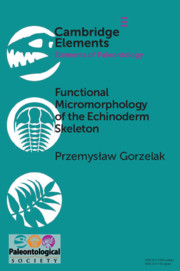Refine search
Actions for selected content:
25 results
Distribution of growth lines in the tube wall of serpulids (Polychaeta, Annelida)
-
- Journal:
- Journal of the Marine Biological Association of the United Kingdom / Volume 104 / 2024
- Published online by Cambridge University Press:
- 05 March 2024, e24
-
- Article
-
- You have access
- Open access
- HTML
- Export citation
Formation of Banded Iron-Manganese Structures by Natural Microbial Communities
-
- Journal:
- Clays and Clay Minerals / Volume 48 / Issue 5 / October 2000
- Published online by Cambridge University Press:
- 28 February 2024, pp. 511-520
-
- Article
- Export citation
Possible Role of Microbial Polysaccharides in Nontronite Formation
-
- Journal:
- Clays and Clay Minerals / Volume 49 / Issue 4 / August 2001
- Published online by Cambridge University Press:
- 28 February 2024, pp. 292-299
-
- Article
- Export citation
Biogeochemical and Environmental Factors in Fe Biomineralization: Magnetite and Siderite Formation
-
- Journal:
- Clays and Clay Minerals / Volume 51 / Issue 1 / February 2003
- Published online by Cambridge University Press:
- 01 January 2024, pp. 83-95
-
- Article
- Export citation
Sustainable construction: Toward growing biocement with synthetic biology
-
- Journal:
- Research Directions: Biotechnology Design / Volume 1 / 2023
- Published online by Cambridge University Press:
- 18 August 2023, e14
-
- Article
-
- You have access
- Open access
- HTML
- Export citation

Functional Micromorphology of the Echinoderm Skeleton
-
- Published online:
- 02 February 2021
- Print publication:
- 11 February 2021
-
- Element
- Export citation
13 - Bio-Composites and Recycling
-
- Book:
- An Introduction to Composite Materials
- Published online:
- 04 July 2019
- Print publication:
- 11 July 2019, pp 268-285
-
- Chapter
- Export citation
Paleometry as a key tool to deal with paleobiological and astrobiological issues: some contributions and reflections on the Brazilian fossil record
-
- Journal:
- International Journal of Astrobiology / Volume 18 / Issue 6 / December 2019
- Published online by Cambridge University Press:
- 19 March 2019, pp. 575-589
-
- Article
- Export citation
Elemental behaviour during the process of corrosion of sekishu glazed roof-tiles affected by Lecidea s.lat. sp. (crustose lichen)
-
- Journal:
- Clay Minerals / Volume 41 / Issue 4 / December 2006
- Published online by Cambridge University Press:
- 09 July 2018, pp. 819-826
-
- Article
- Export citation
Nanoscale pseudobrookite layer in the surface glaze of a Japanese sekishu roof tile
-
- Journal:
- Clay Minerals / Volume 44 / Issue 2 / June 2009
- Published online by Cambridge University Press:
- 09 July 2018, pp. 177-180
-
- Article
- Export citation
Mineralogical approaches to the study of biomineralization in fish otoliths
-
- Journal:
- Mineralogical Magazine / Volume 72 / Issue 2 / April 2008
- Published online by Cambridge University Press:
- 05 July 2018, pp. 627-637
-
- Article
- Export citation
Hierarchical fibre composite structure and micromechanical properties of phosphatic and calcitic brachiopod shell biomaterials — an overview
-
- Journal:
- Mineralogical Magazine / Volume 72 / Issue 2 / April 2008
- Published online by Cambridge University Press:
- 05 July 2018, pp. 541-562
-
- Article
- Export citation
Crystallization of biogenic Ca-carbonate within organo-mineral micro-domains. Structure of the calcite prisms of the Pelecypod Pinctada margaritifera (Mollusca) at the submicron to nanometre ranges
-
- Journal:
- Mineralogical Magazine / Volume 72 / Issue 2 / April 2008
- Published online by Cambridge University Press:
- 05 July 2018, pp. 617-626
-
- Article
- Export citation
Biominerals
-
- Journal:
- Mineralogical Magazine / Volume 69 / Issue 5 / October 2005
- Published online by Cambridge University Press:
- 05 July 2018, pp. 621-641
-
- Article
- Export citation
Analyses of patterns of copper and lead mineralization in human skeletons excavated from an ancient mining and smelting centre in the Jordanian desert: a reconnaissance study
-
- Journal:
- Mineralogical Magazine / Volume 69 / Issue 5 / October 2005
- Published online by Cambridge University Press:
- 05 July 2018, pp. 653-666
-
- Article
- Export citation
Structural characterization and chemical composition of aragonite and vaterite in freshwater cultured pearls
-
- Journal:
- Mineralogical Magazine / Volume 72 / Issue 2 / April 2008
- Published online by Cambridge University Press:
- 05 July 2018, pp. 579-592
-
- Article
- Export citation
Microbially mediated reduction of Np(V) by a consortium of alkaline tolerant Fe(III)-reducing bacteria
-
- Journal:
- Mineralogical Magazine / Volume 79 / Issue 6 / November 2015
- Published online by Cambridge University Press:
- 02 January 2018, pp. 1287-1295
-
- Article
-
- You have access
- Open access
- Export citation
Spectral features of biogenic calcium carbonates and implications for astrobiology
-
- Journal:
- International Journal of Astrobiology / Volume 13 / Issue 4 / October 2014
- Published online by Cambridge University Press:
- 10 September 2014, pp. 353-365
-
- Article
- Export citation
Bacterial communities in Fe/Mn films, sulphate crusts, and aluminium glazes from Swedish Lapland: implications for astrobiology on Mars
-
- Journal:
- International Journal of Astrobiology / Volume 12 / Issue 4 / October 2013
- Published online by Cambridge University Press:
- 05 July 2013, pp. 345-356
-
- Article
- Export citation
A new approach to marine fish otoliths study: electron paramagnetic resonance
-
- Journal:
- Journal of the Marine Biological Association of the United Kingdom / Volume 93 / Issue 7 / November 2013
- Published online by Cambridge University Press:
- 09 May 2013, pp. 1973-1980
-
- Article
- Export citation
